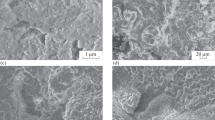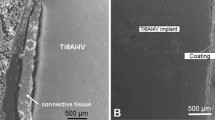Abstract
Using the buy-to-fly ratio for sprayed material, we optimized the method of creating nanostructured plasma coatings based on hydroxyapatite. After plasma spraying, the coating contains 67–83% hydroxyapatite phase. We studied several case of hydrothermal treatment of coatings for the purpose of strengthening them and in order to increase the hydroxyapatite phase content. After hydrothermal treatment of the coating at 650°C, we achieved the value of hydroxyapatite content around 98%. The size of coherentscattering regions grew from 95 to 122 nm. We proved that, after the treatment, the shear strength of hydroxyapatite-based coatings in relation to the titanium substrate is 22.3 MPa.
Similar content being viewed by others
References
Kim, J.S., Kang, S.-M., Seo, K.-W., Nahm, K.-Y., Chung, K.-R., Kim, S.-H., and Ahn, J.-P., Nanoscale bonding between human bone and titanium surfaces: Osseohybridization, Biomed. Res. Int., 2015, vol. 2015, p. 960410. doi 10.1155/2015/960410
Sahay, V., Lare, P.J., and Hahn, H., Physical and mechanical characterization of porous coatings for medical and dental devices. Thermal spray, research and application, in Proc. 3rd Nat. Thermal Spray Conf., Long Beach, CA. USA, pp. 425–430.
Borsari, V., Giavaresi, G., Fini, M., Torricelli, P., Salito, A., Chiesa, R., Chiusoli, L., Volpert, A., Rimondini, L., and Giardino, R., Physical characterization of different-roughness titanium surfaces, with and without hydroxyapatite coating, and their effect on human osteoblast-like cells, J. Biomed. Mater. Res. J. Part B: Appl Biomater., 2005, vol. 75, pp. 359–368.
Borsari, V., Fini, M., Giavaresi, G., Tschon, M., Chiesa, R., Chiusoli, L., Salito, A., Rimondini, L., and Giardino, R., Comparative in vivo evaluation of porous and dense duplex titanium and hydroxyapatite coating with high roughnesses in different implantation environments, J. Biomed. Mater. Res. A, 2009, vol. 89, pp. 550–560.
Gnedovets, A.G., Kalita, V.I., Komlev, D.I., Yerokhin, A.L., and Matthews, A., Plasma spraying of capillary- porous coatings: experiments, modeling and applications, in IVC-16/ICSS-12/NANO-8, Venice, 2004, pp. 398–399.
Kalita, V.I., Bocharova, M.A., Gnedovets, A.G., Truchnicova, A.S., Yerokhin, A.L., Matthews, A., and Shaternicov, B.N., Structure and mechanical properties of novel plasma sprayed titanic capillaryporous for intrabone implants, in IVC-16/ICSS-12/NANO-8, Venice, 2004, pp. 58–59.
Kalita, V.I., Gnedovets, A.G., Mamaev, A.I., Mamaeva, V.A., Malanin, D.A., and Pisarev, V.B., Plasma deposited bioactive porous coatings for intrabone implants, in Abstracts and Full-Papers CDof 17th Int. Symp. on Plasma Chemistry (ISPC-17), Toronto, Canada. 2005, CD Paper 535, pp. 1105–1106.
Tong, W., Effect of particle size on molten states of starting powder and degradation of relevant plasmastrayed hydroxyapatite coatings, Biomaterials, 1996, vol. 17, pp. 1507–1514.
Kalita, V.I. and Gnedovets, A.G., Plasma spraying of capillary porous coating: Experiments, modeling, and biomedical applications, Rlasma Proc. Polym., 2005, vol. 2, pp. 485–492.
Saunin, V.N., Telegin, S.V., Kalita, V.I., and Denisova, E.A., Formation of bulk magnetically soft materials with nano and amorphous structure using plasma sputtering, Inorg. Mater.: Appl. Res., 2012, vol. 3, pp. 201–209.
Jiyong, C., The effect of atmosphere for a phase transition of plasma spraying ha coatings during the thermal treatment, J. Biomed. Mater. Res., 1997, vol. 34, pp. 15–20.
Yang, C.Y., Lee, T.M., Yang, C.W., Chen, L.R., Wu, M.C., and Lui, T.S., In vitro and in vivo biological responses of plasma-sprayed hydroxyapatite coatings with post hydrothermal treatment, J. Biomed. Mater. Res. A, 2007, vol. 83, pp. 263–271.
Tian, Y.S., Qian, X.L., and Chen, M.Q., Effect of saturated steam treatment on the crystallinity of plasmasprayed hydroxyapatite coatings, Surf. Coat. Technol., 2015, vol. 266, pp. 38–41.
Riboud, P.V., Composition and stability of apatites in the system CaO–P2O5–iron oxide–H2O at high temperature, Ann. Chim., 1973, vol. 8, pp. 381–390.
Harris, D.H., Overview of problems surrounding the plasma spraying of hydroxyapatite coatings, in Proc. 3rd Nat. Conf. Thermal Spray Res. Appl., Long Beach, USA, pp. 20–25.
Author information
Authors and Affiliations
Corresponding author
Additional information
Original Russian Text © V.I. Kalita, D.I. Komlev, V.S. Komlev, A.Yu. Fedotov, A.A. Radyuk, 2015, published in Materialovedenie, 2015, No. 10, pp. 42–48.
Rights and permissions
About this article
Cite this article
Kalita, V.I., Komlev, D.I., Komlev, V.S. et al. Hydroxyapatite-based coatings for intraosteal implants. Inorg. Mater. Appl. Res. 7, 486–492 (2016). https://doi.org/10.1134/S2075113316040134
Received:
Published:
Issue Date:
DOI: https://doi.org/10.1134/S2075113316040134




